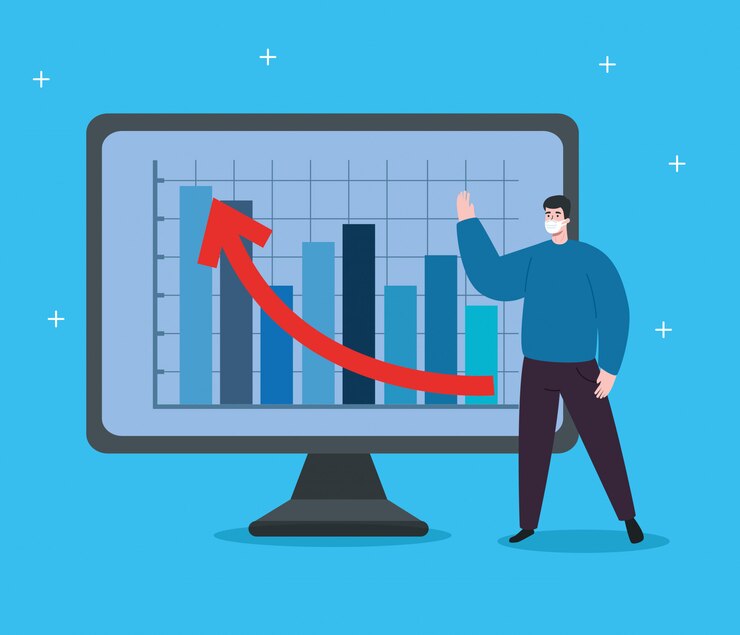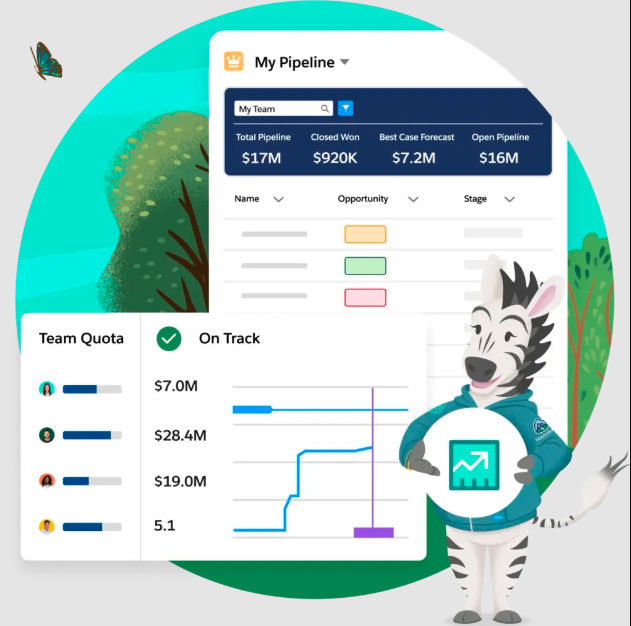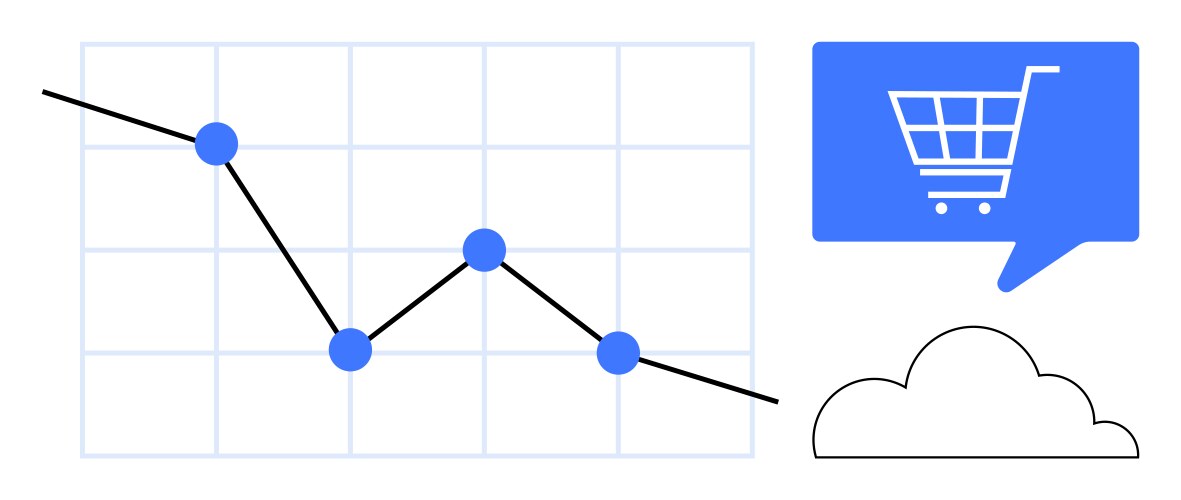Sales forecasting is vital to effective sales management. It enables businesses to make informed decisions about resource allocation and strategic planning.
In today’s competitive landscape, using tools like Salesforce can significantly enhance the accuracy of your sales forecasts.
We discuss the practical tips and best practices for utilizing Salesforce to its fullest potential, ensuring that your forecasts are reliable and actionable.
Focusing on data integrity, automation, and collaborative forecasting can transform your sales forecasting process.
This guide will provide insights into getting the most out of your Salesforce setup to capture accurate data, streamline workflows, and ultimately drive better sales outcomes.
What is Sales Forecasting?
Estimating the business’s future sales revenue over a certain period is known as Sales forecasting.
Businesses use sales forecasting to make better resource allocation, production planning, inventory management, and business strategy decisions.
Every business needs accurate sales forecasting because the findings dictate how the company builds and maintains a competitive advantage.
What are Different Methods of Sales Forecasting?
There are five sales forecasting methods that a company can pick from:
Historical Data Analysis:
- A simple moving average calculates the average of a specific number of past periods.
- The weighted moving average assigns more weight to recent data points.
- Using exponential smoothing gives more weight to recent data but also considers past data.
Statistilca Methods:
- Linear Regression identifies the relationship between sales and other variables (e.g., time, marketing spend).
- A time series analysis will study historical data to identify patterns and trends.
Expert Opinion:
- Salesforce Opinion relies on the expertise of sales representatives to estimate future sales.
- Their executive judgment involves input from senior management to make informed decisions.
Market Research:
- Customer Surveys gather feedback from customers about their purchasing intentions.
- A market analysis studies market trends, competitor activities, and economic indicators.
Machine Learning:
- Predictive analytics uses advanced algorithms to analyze large datasets and make accurate predictions.
What is Salesforce Sales Forecasting?
Sales forecasting is a complex process with several variables influencing the findings. However, Salesforce makes it easier.
Salesforce Lightning forecasting within the CRM helps businesses conduct various tests and collect the information needed to predict future sales numbers.
Salesforce CRM combines historical data with current pipeline data, insights, and sales rep forecasts to build comprehensive estimates for the future.
The most critical components of Salesforce forecasting include:
- Opportunity forecasting helps sales reps estimate the probability of closing deals and their expected revenue.
- Pipeline management offers a visual representation of the sales pipeline, helping to identify potential bottlenecks and opportunities.
- Forecast categories enable the categorization of opportunities into different stages (e.g., qualified, proposal, closed-won).
- Roll-up forecasts aggregate individual sales rep forecasts to generate team and organizational-level forecasts.
- Forecast reporting generates customizable reports to track progress and identify areas for improvement.
Why is Salesforce Forecasting Important?
You now know what Salesforce forecasting is, its components, and who it’s for, but why do businesses need it? What is the purpose of Salesforce forecasting, and how can it help different parts of the company?
Sales Representatives
Sales forecasting helps sales teams set clear goals and targets, using sales engagement strategies to enhance accurate forecasting for clear and achievable sales targets
Sales teams can use real-world data to identify high-potential deals, which allows them to effectively focus their efforts and motivate employees to perform better at their jobs.
Additionally, Salesforce forecasting helps salespeople monitor their performance against assigned targets for continuous improvement and better accountability. You can learn more about the full benefits of Sales Cloud Salesforce to improve your sales management and forecasting.
Managers
Team managers can benefit from Salesforce forecasting with better strategic planning regarding hiring, budgeting, and resource allocation.
Managers can benefit from team performance marketing to track progress and identify their representative’s strengths and weaknesses.
Additionally, sales managers can identify training needs for individuals and teams that bring them up to speed with the group and identify potential pitfalls that are proactively addressed.
Investors
Using the Salesforce CRM as an investor comes with various benefits, including the following:
- Using historical and real-time data to extract business insights for more accurate predictions.
- Automating various forecasting processes to make fewer mistakes and save lots of time.
- Using data for decision-making at every organizational level helps the business grow in productivity and revenue.
9 Tips to Improve Salesforce Sales Forecasting
Salesforce forecasting has shown its capabilities in various areas, and this section teaches businesses how to improve an already powerful tool.
There are nine tips to implement across various areas, each of them being essential:
Tip #1: Build a Strong Technical Foundation
Any system is only as strong as its foundation, and Salesforce forecasting is no different from others.
What does a strong technical foundational foundation for Salesforce forecasting look like? Here’s what you need to know:
Using AI to Improve Sales Forecasting with Salesforce
Sales forecasting and generative AI for sales are the perfect match because a well-programmed algorithm can sift through extensive data and find patterns, trends, and several correlations that humans might overlook.
AI improves sales forecasting with Salesforce using:
- Predictive analytics for historical data analysis to predict future outcomes, e.g., review and deal closure rates.
- Incorporating machine learning algorithms can continuously learn from source data and improve predictions on the go as data becomes readily available.
- Natural language processing (NLP) makes both of these exponentially simpler because the algorithm interprets human-written data more effectively, making it easier to generate insights.
Using Proper Salesforce Forecasting Items
Salesforce Forecasting Items represent the individual deals or opportunities in your sales pipeline. To ensure accurate forecasting, it’s crucial to:
- Keep them up-to-date by regularly reviewing and updating opportunity details, including probability, close date, and amount.
- Categorize them correctly by assigning opportunities to the appropriate forecast category based on their stage in the sales cycle.
- Use consistent criteria to establish clear criteria for categorizing opportunities to maintain consistency across the sales team.
Salesforce Forecast Types
Salesforce offers various forecast types to suit different business needs:
- Opportunity forecasts help individual sales reps forecast their opportunities.
- Pipeline forecasts help managers forecast the overall pipeline for their team.
- Collaborative Forecasts help teams collaborate to refine forecasts and align on expectations.
Tip #2: Build a Strong Business Foundation
Salesforce is a strong system on its own, but the success of the integration also relies on having a strong business foundation.
The business should have its affairs in place for clear directions and an end goal in sight.
Here are four ways to build a strong business foundation:
Seek Accountability
- Set clear expectations by communicating forecasting expectations to sales reps and managers.
- Hold regular reviews that discuss progress, identify issues, and provide feedback.
- Consider incorporating forecast accuracy into performance metrics and incentives.
Build the Right Hierarchy
- Define the roles and responsibilities of sales reps, managers, and forecast administrators.
- Establish a clear reporting structure that accurately ensures forecasts are rolled up from individual reps to team and organizational levels.
Build Routines
- Conducting regular reviews and update forecasts to encourage sales reps to review and update their forecasts frequently.
- Schedule regular forecast meetings where sales teams discuss pipeline health, identify risks, and refine forecasts.
Track Your Salesforce Forecast Accuracy
- Compare actual vs. forecast results to determine how well the existing strategy has performed.
- Analyze forecast errors to identify patterns in forecast errors to improve future predictions.
- Historical data can inform future forecasts because it shows what worked and what failed, giving perspective on the matter.
Tip #3: Know Your Probability
Every sales team needs to know where they stand regarding how much value they can offer a prospect when trying to close a sale.
Probability represents the likelihood of a lead turning into a conversion and generating revenue for the company.
The business needs to know its probability; for example, a 60% probability represents a 60% chance of closing a deal.
Analyzing historical data helps sales teams find historical win rates for different deal stages, which allows the business to accurately map out probabilities for current opportunities on the horizon.
Sales teams shouldn’t have overly pessimistic or optimistic probability assessments simply because they feel it’s right and should rely on historical and real-time data instead.
Tip #4: Align Your Sales Stages to Salesforce Forecast Categories
Every sales stage must be aligned with the proper Salesforce forecast categories for sales teams to get accurate forecasting.
This ensures deals are categorized correctly to avoid confusion for sales teams and customers.
Clearly define map stages into categories. For example, you might map the “Qualification” stage to the “Pipeline” category and the “Closed Won” stage to the “Closed Won” category.
Sales reps must consistently use the same stage and category definitions for organization-wide consistency.
The mapping between stages and categories can be updated at various points depending on the time’s needs.
Tip #5: Know How Forecasts Roll Up
Understanding how forecasts roll up is essential for accurate top-down forecasting.
This involves understanding how individual sales rep forecasts contribute to team and organizational forecasts.
- Clearly understand the hierarchical structure of your sales organization, including how teams and individuals are organized, as well as the role of your sales funnel in this process.
- Verify that forecasts are rolling up correctly from individual reps to team leads and managers.
- If you identify discrepancies in rolled-up forecasts, investigate the root cause and take corrective action.
How Salesforce Forecasts Roll Up
Another component of understanding Salesforce forecasting involves understanding the hierarchical rollups.
A clear hierarchal structure vividly depicts the sales pipelines, helping the business identify potential risks and opportunities.
This is what a Salesforce forecast roll-up looks like:
- An individual sales pep forecasts their opportunities, assigning probabilities and expected revenue to each deal.
- Team leads aggregate the forecasts of their individual sales reps, reviewing and adjusting as needed.
- Sales managers consolidate the forecasts of their team leads, reviewing and adjusting as necessary.
- The Executive leadership reviews the overall organizational forecast, making final adjustments and approvals.
Tip #6: Add Sales Quotas to Your Forecasts
Sales quotas are predetermined targets that teams or individual reps are expected to deliver during a specific period.
Comparing this sales quota to actual sales numbers highlights whether the sales team performs over or under expectations.
Reps struggling to meet their targets can get individual coaching regarding their progress and improvement areas.
High-performing reps can use their sales numbers to justify their performance-bound incentives and be paid sufficiently for their competence.
Tip #7: Leverage Judgment, Adjustments & Collaborative Forecasting
Despite AI integrations and an app for everything, there is still no replacement for human judgment and collaboration regarding forecasting.
Here’s how human oversight is essential for accurate sales forecasting:
- Leverage judgment and expertise to make informed adjustments to forecasts, especially when dealing with complex deals or uncertain market conditions.
- Encourage Collaboration among sales reps, team leads, and managers. Regular discussions and shared insights can help identify potential risks and opportunities.
- Salesforce offers collaborative forecasting features that enable teams to refine forecasts and align on expectations.
Tip #8: Enable Historical Trending
Historical trending is a powerful feature in Salesforce that allows you to analyze past performance data to identify patterns and trends. By enabling historical trending, you can:
- Identify seasonal patterns to recognize recurring patterns in sales data, such as seasonal fluctuations or cyclical trends.
- Benchmark performance to compare current performance to historical benchmarks to identify areas for improvement.
- Predict future trends to use historical data to forecast performance and make informed decisions.
Tip #9: Use Einstein AI
Salesforce Einstein, powered by artificial intelligence, can significantly enhance your forecasting capabilities. By leveraging machine learning, Einstein can:
- Predict deal outcomes by analyzing historical data to predict the likelihood of deal closure.
- Identify key deal drivers influencing deal outcomes, such as deal size, industry, or customer segment.
- Optimize sales processes to recommend optimal next steps to increase deal closure rates and improve sales efficiency.
- Personalize sales outreach using AI-powered insights to personalize sales outreach and improve customer engagement.
How Folio3 Can Help with Salesforce Optimization
Folio3 has two decades of IT service experience across various domains and industries, including sales cloud implementation.
Our team helps with Salesforce consulting and implementation, platform integrations, customization and migration, analytics and BI, and post-deployment support.
The Folio3 Salesforce team helps with:
- Sales
- Marketing
- Commerce
- Data
- Customer service
- Salesforce Einstein AI
- Salesforce Agentforce
We have clients from the health, automotive, manufacturing, financial services, and non-profit industries, which gives us a broad understanding of these industries.
Folio3 clients get best-in-class service from the first call to final deployment and beyond because we believe in retaining customers for life.
Conclusion
Utilizing Salesforce for sales forecasting transforms how businesses predict and manage their sales performance.
Organizations can create accurate forecasts that reflect real-time data and trends by leveraging its robust tools and features.
This approach enhances visibility into the sales pipeline and fosters collaboration among sales teams, enabling them to make informed decisions based on reliable insights.
Implementing best practices such as regular pipeline reviews, aligning opportunity stages with the sales process, and utilizing predictive analytics can significantly improve forecast accuracy. A Sales Cloud expert can help you with these practices to enhance your forecasting.
Embracing a data-driven culture within your sales organization ensures that every team member contributes to maintaining up-to-date information, ultimately leading to more precise forecasts and better strategic planning.
FAQs
How to Do a Sales Forecast?
The sales forecast process includes the following:
- Collecting historical sales data.
- Running data analysis for trends and patterns.
- Picking a forecasting method, e.g., exponential smoothing or linear regression.
- Using the forecasting method to map out future sales predictions.
- Run regular reviews and adjust the forecasts where relevant.
How to Calculate Sales Forecast?
Sales forecast calculations depend on which forecast method you’ve chosen to work with, such as:
- Simple Moving Average: Average sales from a specific number of past periods.
- Exponential Smoothing: Assigns weights to past data, giving more weight to recent data.
- Linear Regression: Uses statistical analysis to identify a trend line.
How to predict a sales Forecast?
Sales forecast predictions are made using historical data analysis, statistical methods, expert opinions, market research, and AI-powered tools to make accurate predictions.
Does Salesforce Have Sales Forecasting?
Yes, Salesforce has a tool called Customizable Forecasting that helps you predict future sales. It uses past data to make educated guesses.
What is the Forecasting Method of Salesforce?
Salesforce uses various methods, including historical data analysis, statistical modeling, and expert judgment.
Who is responsible for sales forecasting?
Sales managers and forecast administrators oversee and manage sales forecasting processes. However, individual sales reps contribute by providing input on pipeline opportunities.

Navaid Ahmed
Director Of Engineering at Folio3 Software | Head of Product Management
Navaid Ahmed is a Seasoned Salesforce CRM expert, who brings a wealth of experience in optimizing sales processes, enhancing customer relationships, and driving business growth. With a deep understanding of Salesforce's capabilities, Navaid specialize in crafting tailored solutions that empower organizations to streamline operations, boost productivity, and achieve their sales objectives.



